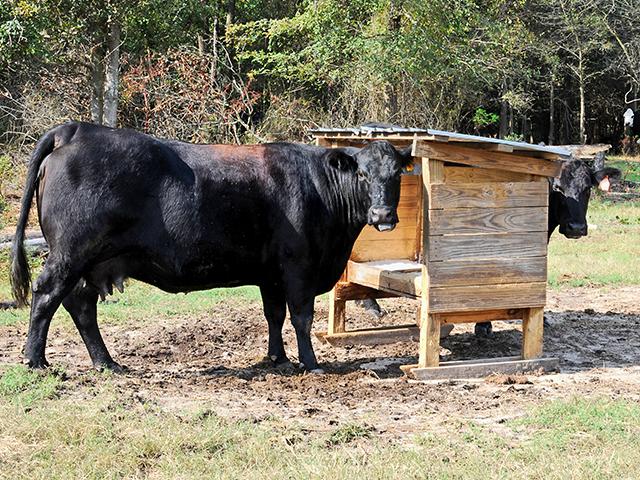Ask the Vet
Cows' Hooves Tell Their Stories
READER: My cows' hooves are splitting. These are my mature cows. What do I need to do about this?
DR. McMILLAN: Cracks in hooves are fairly common in cattle, and many factors can be involved, including environment, size and body condition of the cow, size and shape of the claw, nutrition and genetics.
Horizontal cracks are usually associated with stressful events like calving, illness or changes in nutrition. A cow's hoof is a history book of the life of that cow, and there are grooves that relate to changes during the last year or so. Grooves are normal, but severe disruption can lead to a crack in the claw or claws. If the crack is full thickness, it can pinch the sensitive hoof underneath and lead to pain and lameness. In these cases, your veterinarian needs to remove the lower portion, or "thimble."
Vertical or sand cracks are more common. In most cases, sand cracks are not full thickness, and the hoof responds by thickening and becoming stronger around the crack. Sand cracks are most common on the outside claw of the front foot. Fortunately, sand cracks rarely lead to lameness. When we see a lame cow with a sand crack, we look for another issue that may be causing pain, such as an abscess.
Some breeds seem predisposed to cracks, and even some family lines within a breed are more likely to develop cracks. Other reasons we see cracks include vitamin and mineral deficiencies, aging cows and moisture. Wet conditions soften the hoof, and this can lead to a number of foot problems and even lameness. Very dry conditions can also be a problem, leading to brittle hooves, which are much more prone to cracking.
P[L1] D[0x0] M[300x250] OOP[F] ADUNIT[] T[]
No matter the cause, if there is lameness, the cows need treatment. If the crack is full thickness and unstable, it needs to be cleaned out. Often, we wire the crack together to stabilize, allowing the hoof to regrow normally.
So what can you do to help prevent cracks? Avoiding sudden nutritional changes is always good management. In addition, make sure cattle always have access to a high-quality, complete vitamin and mineral formulated for your area and meeting the needs of your cattle. If cattle have very long toes, foot-trimming may be required. Lastly, watch for any genetic trends, and use this in making culling decisions moving forward.
READER: I have seen several reports in the newspaper and online about pet deaths and illnesses related to the use of Seresto collars. What can you tell me about this?
DR. McMILLAN: Many reports have been submitted to the EPA regarding pet illnesses owners felt were related to the use of Seresto flea collars. EPA is the federal agency that approves and oversees all topical insecticides. In my practice, I have seen no proof of severe illness or death caused by Seresto. Elanco, the maker of Seresto, maintains the collar is safe based on internal studies. A company-financed analysis found that the two chemicals in Seresto, imidacloprid and flumethrin, have not been responsible for any pet deaths.
We have used this product since its release more than 10 years ago and have had very few issues and no deaths. We have had some pets with minor issues, including skin irritation, lethargy and loss of appetite, but these were resolved when the collar was removed.
There have been issues with fake Seresto collars purchased through online sellers. The only issue our clients reported regarding these collars has been a lack of efficacy. But, with counterfeit merchandise from China, you never know what could be in those collars.
I always advise that you read and follow label directions exactly. Proper placement of the collar is essential. Make sure two fingers can fit between the collar and the neck. Any excess collar length should be cut off. If your pet has any issues, immediately remove the collar and call your veterinarian. You can also report problems to the EPA.
Collars are not our primary recommendation for flea and tick control. We feel the isoxazoline class of flea and tick products are the best option for most pets. These include Bravecto, Bravecto Plus, NexGard, Simparica, Simparica Trio, Revolution Plus and Credelio.
No flea and tick product is 100% safe, but fleas and ticks are 100% dangerous. Please consult with your veterinarian to find the best parasite-control program and product or products for your pets. If you feel there is an issue, talk to your veterinarian.
**
-- Please contact your veterinarian with questions pertaining to the health of your herd. Every operation is unique, and the information in this column does not pertain to all situations. This is not intended as medical advice but is purely for informational purposes.
-- Write Dr. Ken McMillan at Ask The Vet, 2204 Lakeshore Dr., Suite 415, Birmingham, AL 35209, or email vet@progressivefarmer.com
[PF_0523]
(c) Copyright 2023 DTN, LLC. All rights reserved.




